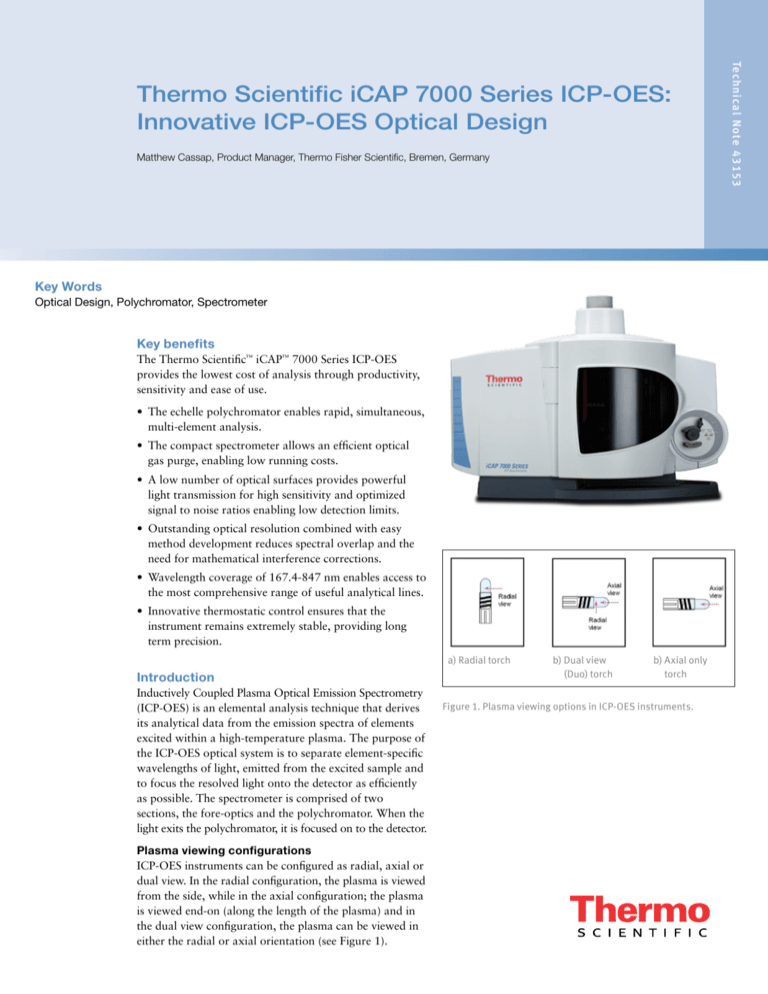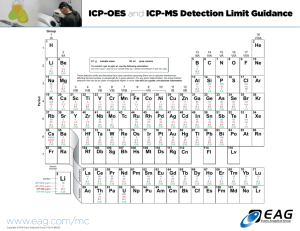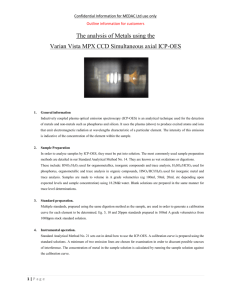
Matthew Cassap, Product Manager, Thermo Fisher Scientific, Bremen, Germany
Key Words
Optical Design, Polychromator, Spectrometer
Key benefits
The Thermo Scientific™ iCAP™ 7000 Series ICP-OES
provides the lowest cost of analysis through productivity,
sensitivity and ease of use.
• The echelle polychromator enables rapid, simultaneous,
multi-element analysis.
• The compact spectrometer allows an efficient optical
gas purge, enabling low running costs.
• A low number of optical surfaces provides powerful
light transmission for high sensitivity and optimized
signal to noise ratios enabling low detection limits.
• Outstanding optical resolution combined with easy
method development reduces spectral overlap and the
need for mathematical interference corrections.
• Wavelength coverage of 167.4-847 nm enables access to
the most comprehensive range of useful analytical lines.
• Innovative thermostatic control ensures that the
instrument remains extremely stable, providing long
term precision.
a) Radial torch
Introduction
Inductively Coupled Plasma Optical Emission Spectrometry
(ICP-OES) is an elemental analysis technique that derives
its analytical data from the emission spectra of elements
excited within a high-temperature plasma. The purpose of
the ICP-OES optical system is to separate element-specific
wavelengths of light, emitted from the excited sample and
to focus the resolved light onto the detector as efficiently
as possible. The spectrometer is comprised of two
sections, the fore-optics and the polychromator. When the
light exits the polychromator, it is focused on to the detector.
Plasma viewing configurations
ICP-OES instruments can be configured as radial, axial or
dual view. In the radial configuration, the plasma is viewed
from the side, while in the axial configuration; the plasma
is viewed end-on (along the length of the plasma) and in
the dual view configuration, the plasma can be viewed in
either the radial or axial orientation (see Figure 1).
b) D
ual view
(Duo) torch
b) A
xial only
torch
Figure 1. Plasma viewing options in ICP-OES instruments.
Te ch ni cal N ote 4 3 1 5 3
Thermo Scientific iCAP 7000 Series ICP-OES:
Innovative ICP-OES Optical Design
2
The dedicated radial plasma view is accepted as the
configuration with the highest tolerance for high dissolved
solids and other complex matrices. This is due to lower
levels of matrix interferences in the region of the plasma
that is viewed. The radial plasma view offers less sensitivity
than the axial view, however, it is preferable for analyzing
difficult samples such as organics or very high dissolved
solid matrices, as the plasma viewing position can be
optimized to reduce background emissions.
The axially viewed plasma configuration offers greater
sensitivity than radial configuration, but has higher
susceptibility to matrix interferences, as the entire plasma
is viewed, increasing the quantity of light observed from
both analyte and background emissions. However,
combining an axial plasma view with an automatically
switchable radial plasma view in the dual plasma view
configuration produces a sensitive, versatile instrument
with the ability to handle a wide range of samples with
complex matrices. The switching between the two plasma
views is carried out by the fore-optics (Figure 2).
Versatility:
• Broad wavelength coverage and the ability to
simultaneously capture the entire analytical spectrum.
• Fore-optic design to enable model configurations with
either a dedicated radial plasma view or a dual plasma
view configuration.
• Compact optical design to enable a small instrument
footprint.
The focus on the three principles highlighted above
enables the iCAP 7000 Series ICP-OES to deliver
exceptional cost efficiency through increased sample
throughput and reduced gas consumption.
iCAP 7000 Series ICP-OES Fore-Optic
iCAP 7000 Series ICP-OES Duo
The fore-optics of the Duo viewing configuration consists
of tandem view mirrors and a plasma focusing mirror
– the absolute minimum number of surfaces for the
required design, as shown in Figure 3. The mirror
arrangement optimizes the view into the axial sample
channel and radial view of the plasma in two-dimensions
using software control. The tandem viewing mirror in the
Duo configuration has been designed to enable rapid
switching between radial and axial plasma views during
sample analysis for enhanced productivity and flexibility.
Figure 2. A simplified linear schematic of an ICP-OES instrument showing the purpose of
each major component.
Thermo Scientific iCAP 7000 Series ICP-OES
optical system
The Thermo Scientific iCAP 7000 Series ICP-OES
incorporates an optical design which combines highperformance simultaneous analytical performance with
cost-efficiency. The primary requirements for the optical
design are listed below:
Performance:
• Optimized light transfer in both the ultra visible (UV)
and visible ranges to enable high sensitivity and
excellent analytical detection capability for all commonly used wavelengths.
• High resolution to reduce spectral interferences and
improve analysis in spectrally rich solutions.
Productivity:
• Rapid, accurate analysis with simultaneous
measurement of analyte, background and internal
standard wavelengths.
• Thermal and mechanical stabilization of all optical
components to achieve exceptional long-term stability,
reducing the need for frequent recalibrations.
• Distributed optical gas purge for rapid installation,
start-up and low gas consumption costs.
Figure 3: Schematic of the iCAP 7000 Series ICP-OES Duo fore-optics.
The iCAP 7000 Series ICP-OES Duo design uses the
minimum number of fore-optics surfaces and movable
parts and is a stable and versatile platform with highefficiency light transfer for the transmission of the
maximum amount of elemental emission in the minimum
time. Unlike a dual view design, axial only instruments do
not have the versatility of the added radial view mode for
improved interference and matrix-handling and may not
be able to analyze some types of samples effectively.
iCAP 7000 Series ICP-OES Radial
The fore-optics in the dedicated radial instrument consists
of a view mirror and a focusing mirror, as shown in
Figure 4. The mirror arrangement used enables the
optimization of the plasma viewing height, enabling
viewing of the region of maximum analyte intensity in
the plasma.
3
Figure 5: Schematic of iCAP 7000 Series ICP-OES optical tank
layout, showing light path.
Figure 4: Schematic of the iCAP 7000 Series ICP-OES Radial foreoptics.
Inefficient and poorly designed fore-optics purge systems
result in UV absorption between the plasma and the
fore-optics and poor UV sensitivity. The iCAP 7000 series
Purged Optical Pathway (POP) tube design and optimized
purge gas flow eliminates this problem in both Radial and
Duo versions by providing an efficiently purged pathway
between the plasma and the fore-optics.
Polychromator Design
The Thermo Scientific iCAP 7000 Series ICP-OES utilizes
an echelle spectrometer with a focal length of 383 mm
and a unique configuration of a minimal number of
all-spherical mirrors enabling high optical resolution of
7 pm at 200 nm in a compact design. It provides
comprehensive, virtually continuous wavelength coverage
in the range of 167.4 nm to 847.0 nm, allowing the option
of alternate wavelength selection in the presence of spectral
interferences, e.g. the interference of iron on boron at
249.777 nm in steel samples. In this case, boron can simply
be analyzed at 208.959 nm instead. The innovatively
designed polychromator enables exceptionally high light
transfer efficiency with minimal light scattering to deliver
high analytical performance. As the light from the plasma
enters the polychromator, it is selectively focused through
two optimized slits. The use of this two slit configuration
enables optimal light transmission across the entire
UV-Visible wavelength range for optimal analytical
performance.
Once the light passes through the entrance slit it is focused
on the prism, by the prism mirror. The prism then
separates the light by wavelength in a single dimension, at
low resolution. An echelle grating orders the separated
light, from the prism, in the other dimension. This creates a
high resolution, two-dimensional spectrum, known as an
echelleogram. After passing through the prism for the
second time, the camera mirror collects and focuses the
now completely dispersed spectrum onto the charge
injection device detector (CID). The uniquely angled and
positioned, all-spherical mirror design transfers the slit
image to the detector with minimal degradation of
resolution, regardless of element wavelength/order position
on the chip. The final two dimensional spectrum is used
for the interpretation of the resultant analyte signals. The
excellent resolution achieved by the innovative optical
design is demonstrated by the spectrometer’s ability to
resolve the thallium doublet as 190.856 nm and 190.870
nm, shown in Figure 6.
Figure 6: Thallium doublet from the iCAP 7000 Series ICP-OES,
shown in raw pixel form. The well separated doublet peaks
indicate the high resolution of the spectrometer.
Te ch ni cal N ote 4 3 1 5 3
Thermal stabilization
The iCAP 7000 Series ICP-OES polychromator is
thermostatically controlled at 38 ± 0.1 °C using a
thermally conductive heating blanket, covered by an
insulating, thermal foam layer to ensure optimum thermal
stability. In addition, a thermal break is incorporated into
the design of the interface between the optics and the
torch box which enables analytical stability.
Optical purge design
Gases common in air, such as oxygen and carbon dioxide,
can absorb much of the intensity of UV radiation
(< 190 nm). Therefore in order to enable the sensitive
analysis of analytes in this wavelength region, the use of a
purge system in the polychromator, fore-optics and the
plasma interface is critical.
The iCAP 7000 Series ICP-OES uses a unique distributed
gas purge system which purges the polychromator
uniformly and is it integral to the design of the fore-optics
and plasma interface. The purge system can be configured
to use either argon or nitrogen gas and was developed
using Computational Fluid Dynamics (CFD) techniques,
in order to examine and optimize the purge gas flow,
thermal distribution, gradients and stability. The compact
design and low volume optical tank ensures quick and
efficient purging using minimum gas flows.
The purge gas exits the optical system through the POP
tube, enabling the removal of constituents in the plasma
interface that may otherwise absorb the UV light intensity,
as shown in Figure 7. Additionally, the POP tube purge
gas flow provides a counter flow of argon to occlude
environmental factors, such as dust and soot, removing
the interferences they cause. Some other ICP-OES designs
are required to use additional gas flows such as a shear
gas, to optimize their plasma interface. This can increase
instrument running costs, interfere with light transmission
or requires expensive accessories such as air compressors
to be purchased with the instrument.
The iCAP 7000 Series ICP-OES has been designed to
include the minimum number of components in the
polychromator and there are no electronic components
present in the optical tank which can compromise the
optical performance with out-gassing. When out-gassing
occurs in a system without a purge gas i.e. a sealed,
recirculating system, the compounds that are given off in
the optical chamber may coat the optical components,
drastically reducing optical light transfer. The use of a
free-flowing purge gas additionally avoids the requirement
for the use of expensive gas pumps and scrubbers.
Figure 7: Schematic of the POP tubes for Duo (above) and Radial
(below) instruments.
Conclusion
The optical design of the Thermo Scientific iCAP 7000
series ICP-OES, echelle polychromator produces high light
throughput, providing exceptional sensitivity and
outstanding resolution. This high resolution enables the
analyst to avoid many spectral interferences which would
otherwise cause problems during analysis. Combining
these effects with an efficient optical purge and careful
thermal stabilization produces a spectrometer system with
superlative analytical performance and low gas consumption.
This allows the analyst to provide the greatest quality of
results while minimizing cost of ownership.
www.thermoscientific.com
©2014 Thermo Fisher Scientific Inc. All rights reserved. ISO is a trademark of the International Standards Organization.
All other trademarks are the property of Thermo Fisher Scientific and its subsidiaries. This information is presented as an
example of the capabilities of Thermo Fisher Scientific products. It is not intended to encourage use of these products in any
manners that might infringe the intellectual property rights of others. Specifications, terms and pricing are subject to change.
Not all products are available in all countries. Please consult your local sales representative for details.
Africa +43 1 333 50 34 0
Australia +61 3 9757 4300
Austria +43 810 282 206
Belgium +32 53 73 42 41
Canada +1 800 530 8447
China 800 810 5118 (free call domestic)
400 650 5118
Denmark +45 70 23 62 60
Europe-Other +43 1 333 50 34 0
Finland +358 9 3291 0200
France +33 1 60 92 48 00
Germany +49 6103 408 1014
India +91 22 6742 9494
Italy +39 02 950 591
Japan +81 45 453 9100
Latin America +1 561 688 8700
Middle East +43 1 333 50 34 0
Netherlands +31 76 579 55 55
New Zealand +64 9 980 6700
Norway +46 8 556 468 00
Russia/CIS +43 1 333 50 34 0
Thermo Fisher Scientific (Bremen)
GmbH Management System
Registered to ISO 9001:2008
Singapore +65 6289 1190
Spain +34 914 845 965
Sweden +46 8 556 468 00
Switzerland +41 61 716 77 00
UK +44 1442 233555
USA +1 800 532 4752
TN43153-EN 0814S








